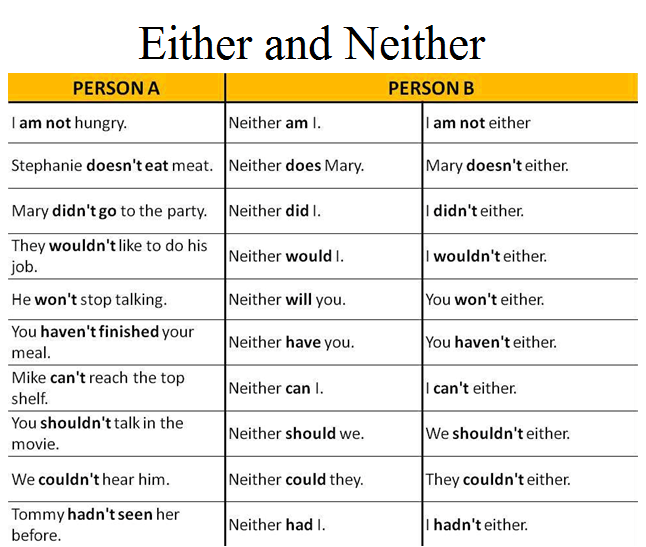Agreement or disagreement
“Either y neither” (tampoco) = se usan en frases negativas y expresan dos acciones idénticas; también tienen el mismo significado pero su orden en la oración es diferente.
Ex:
He isnot happy (el no es feliz).
I am not either (yo no soy tampoco).
Neither am I (tampoco lo soy yo).
I donot like rats. She doesn´t either. Neither does she.
We won´t go there. He won´t either. Neither will he.
I can´t help him. They can´t either. Neither can they.
She hasn´t bought it. You haven´t either. Neither have you.

“Too” y “so” (también) = se usan para expresar 2 acciones idénticas, y se usan en frases afirmativas; tienen el mismo significado, pero su orden en una oración es diferente.
She is hungry (ella esta hambrienta).
I am too (yo estoy también).
So am I (también lo estoy yo).
Note que dependiendo de tiempo gramatical y/o verbo auxiliar que se usen en la primera oración, de eso dependerá la construcción de las demás fases que llevan “too y so”:
I can do it (él puede hacerlo).
He can too (él puede también).
So can he (así puede él, también puede él).
He likes to drink (a él le gusta beber).
I do too (yo lo hago también).
So do I (así lo hace él, también lo hago yo).
He went to the cinema (él fue a el cine).
I did too (yo lo hice también).
So did I (también lo hice yo).
She will go there (ella ira allá).
He will do it too = he will too (él lo hará también).
So will he (también lo hará él).
I have been studying. She has too. So has she.
You should come with us. They should too. So should they.
We could see it. He could too. So could he.



